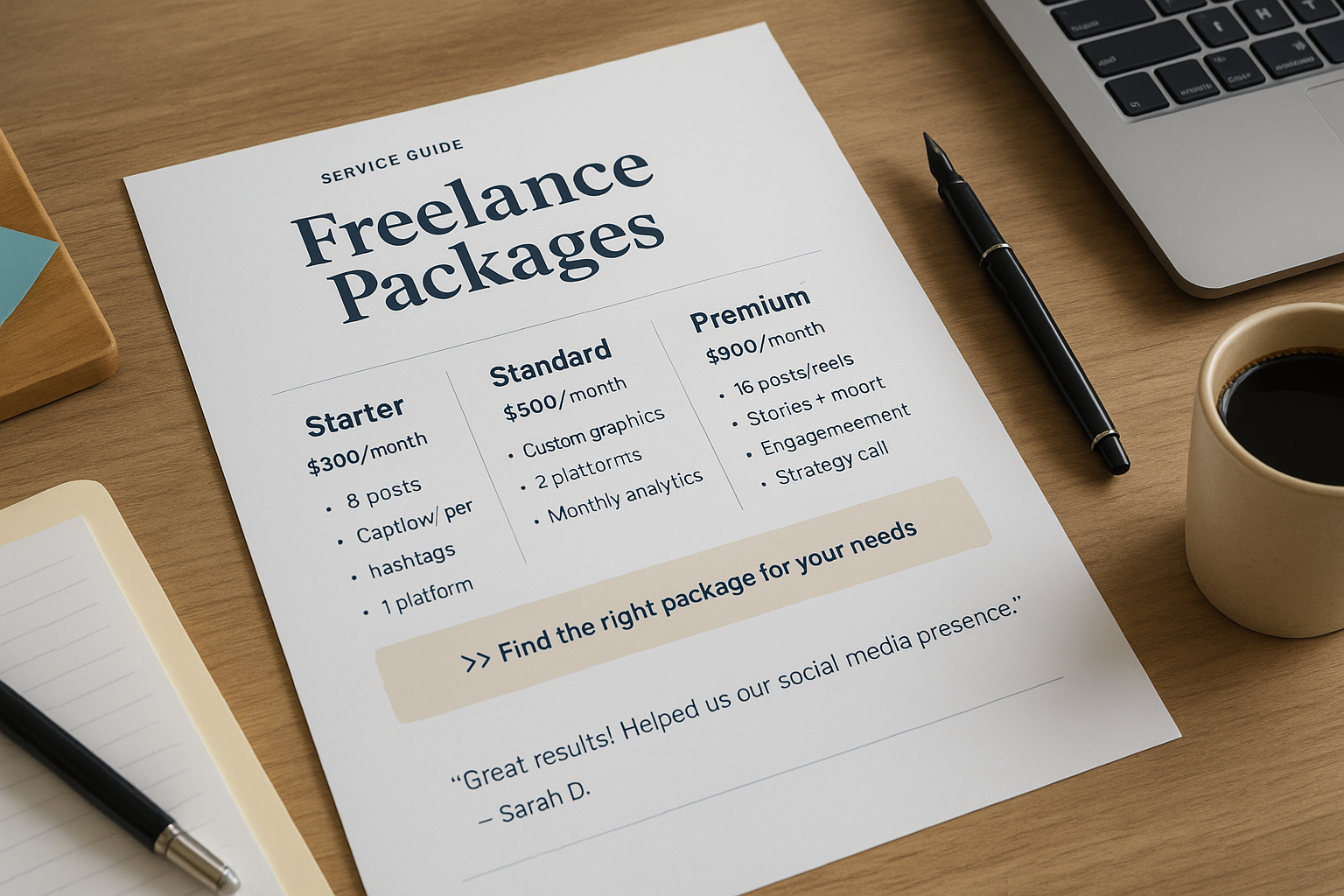If you’re still charging by the hour or custom-quoting every project, you might be leaving money—and time—on the table. One of the best ways to increase income, simplify your offers, and attract better clients is to create freelance service packages. Packages help clients understand what they’re getting, and they help you position your value more clearly. In this article, you’ll learn how to build high-converting freelance packages that make selling your services easier.
What Is a Freelance Package?
A freelance package is a predefined set of services offered at a fixed price. It may include deliverables, timelines, revision limits, and bonuses.
Instead of saying, “I charge $50/hour,” you say:
“My blog content package includes 4 SEO-optimized posts/month for $600.”
✅ Easier to market
✅ Easier for clients to understand
✅ Easier to scale and systemize
Benefits of Freelance Packages
- Clarity – Clients know what they’re buying
- Efficiency – You streamline your process
- Consistency – You control your workflow and pricing
- Positioning – You look like a specialist, not a task-taker
- Profitability – You can price for value, not time
And clients LOVE clear offers.
Step 1: Define Your Core Service
Start by choosing the service you’re best at—or the one your ideal client needs most.
Examples:
- Website design
- Email marketing setup
- Blog writing
- Social media management
- Logo and brand identity
- Funnel building
- Podcast editing
- Virtual assistance
Pick a service that solves a specific problem.
Step 2: Choose a Clear Outcome
Clients pay for results, not just deliverables.
Instead of offering:
“3 hours of admin support”
Offer:
“Inbox organization + weekly task automation setup”
Frame your service around the outcome:
✅ What does the client walk away with?
✅ How does their life/business improve?
Step 3: Build 2–3 Tiered Options
Offering 2–3 packages helps clients compare options and choose the one that fits their budget and needs.
Structure:
- Basic – A starter version with fewer deliverables
- Standard – Your “core” offer, priced for value
- Premium – More support, faster delivery, or added bonuses
Example (Social Media Management):
Starter – $300/month
• 8 posts/month
• Caption writing + hashtags
• 1 platform
Standard – $500/month
• 12 posts/month
• Custom graphics
• 2 platforms
• Monthly analytics
Premium – $900/month
• 16 posts/month
• Stories + reels
• Engagement support
• Strategy call
Make your middle tier the most attractive one—this is called price anchoring.
Step 4: Set Boundaries and Scope
Prevent scope creep by clearly defining:
- Number of revisions
- Turnaround times
- Communication methods
- What’s NOT included (if needed)
Clarity protects your time and keeps clients happy.
Step 5: Add Bonus Value (Without More Work)
Small extras can make your package feel premium.
Examples:
- Quick-start guide
- Strategy checklist
- Monthly performance report
- Template or swipe file
- 15-minute onboarding call
These don’t take much time—but they increase perceived value.
Step 6: Price for Profit—Not Just Time
Packages should be priced based on value and outcome, not just how long they take.
Ask yourself:
- What’s this worth to the client?
- What results can they expect?
- What would it cost them to do this themselves?
Then price accordingly. You’re selling expertise, not just hours.
Step 7: Design a Service Guide or Sales Page
Make your packages easy to view and share.
Options:
- PDF service guide (Canva, Notion, or Google Docs)
- Pricing page on your website
- Sales page with testimonials and portfolio samples
- Simple one-pager on Carrd or Leadpages
Use visuals, clear copy, and CTAs (“Book Now” or “Let’s Talk”).
Step 8: Include Testimonials and Case Studies
Social proof sells your packages. Add:
- Client quotes
- Before-and-after screenshots
- Portfolio links
- Video testimonials (if possible)
If you’re just starting out, use feedback from past projects, internships, or even mock projects.
Step 9: Make It Easy to Buy
Eliminate friction from the sales process.
✅ Include a clear CTA
✅ Use a booking link (Calendly, TidyCal)
✅ Offer a payment system (PayPal, Stripe, Wise)
✅ Send a proposal or contract quickly after the inquiry
The easier it is to say yes, the more yeses you’ll get.
Step 10: Test, Refine, Repeat
Your first package is a starting point. Adjust based on:
- Client feedback
- What people ask for most
- What’s most profitable for you
- What feels sustainable long-term
Track conversion rates, average client value, and delivery time to improve over time.
Final Thoughts: Packages Create Power
Freelance packages help you move from “freelancer-for-hire” to trusted service provider.
They make selling easier. They make delivery smoother. They make scaling possible.
So instead of offering “freelance work,” offer:
✅ Clarity
✅ Value
✅ Results
That’s what clients are really buying.

